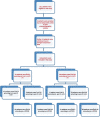End-tidal carbon dioxide's change to fluid challenge versus internal jugular vein dispensability index for predicting fluid responsiveness in septic patients: A prospective, observational study
- PMID: 37476446
- PMCID: PMC10355349
- DOI: 10.4103/ija.ija_52_23
End-tidal carbon dioxide's change to fluid challenge versus internal jugular vein dispensability index for predicting fluid responsiveness in septic patients: A prospective, observational study
Abstract
Background and aims: The prediction of fluid responsiveness is crucial for the fluid management of septic shock patients. This prospective, observational study was conducted to compare end-tidal carbon dioxide (ETCO2) change due to fluid challenge (FC-induced ΔETCO2) versus internal jugular vein distensibility index (IJVDI) as predictors of fluid responsiveness in such patients.
Methods: Septic hypoperfused mechanically ventilated patients were classified as fluid responders (Rs) and non-responders (NRs) according to the improvement of left ventricular outflow tract-velocity time integral (ΔLVOT-VTI) after fluid challenge (FC). The receiver operating characteristic (ROC) curves of FC-induced ΔETCO2, pre-(FC) IJVDI and their combination for prediction of fluid responsiveness were compared to that of ΔLVOT-VTI% as a gold standard.
Results: Of 140 patients who completed the study, 51 (36.4%) patients were classified as Rs and 89 (63.6%) patients as NRs. With regard to the prediction of fluid responsiveness, no significant difference (P. 0. 384) was found between the diagnostic accuracy of FC-induced ΔETCO2 >2 mmHg (area under the ROC curve [AUC] 0.908, P < 0.001) and that of pre-(FC) IJVDI >18% (AUC 0.938, P < 0.001), but a prediction model combining both markers, ΔETCO2 ≥3 mmHg and IJVDI ≥16%, achieved significantly higher accuracy (AUC 0.982, P < 0.001) than each independent one (P < 0.05).
Conclusion: Under stable ventilatory and metabolic conditions, the predictivity of FC-induced ΔETCO2 >2 mmHg can be comparable to that of pre-(FC) IJVDI >18%. A predictive model combining both FC-induced ΔETCO2 ≥3 mmHg and IJVDI ≥16% can provide higher accuracy than that recorded for each one independently.
Keywords: Carbon dioxide; end-tidal carbon dioxide; fluid challenge; fluid responders; internal jugular vein dispensability index; resuscitation; sepsis; shock.
Copyright: © 2023 Indian Journal of Anaesthesia.
Conflict of interest statement
There are no conflicts of interest.
Figures


References
-
- Xiao-ting W, Hua Z, Da-wei L, Hong-min Z, Huai-wu H, Yun L, et al. Changes in end-tidal CO2 could predict fluid responsiveness in the passive leg raising test but not in the mini-fluid challenge test: A prospective and observational study. J Critical Care. 2015;30:1061–6. - PubMed
-
- Monnet X, Bataille A, Magalhaes E, Barrois J, Le Corre M, Gosset C, et al. End-tidal carbon dioxide is better than arterial pressure for predicting volume responsiveness by the passive leg raising test. Intensive Care Med. 2013;39:93–100. - PubMed
LinkOut - more resources
Full Text Sources
